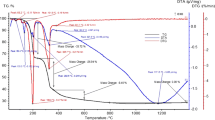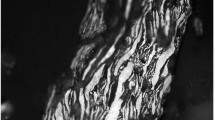Abstract
In this study, a three-step synthesis process is proposed for the production of submicron B4C powders. The initial step is the mechanical activation of a Mg–C–B2O3 mixture, which is carried out by using a high-energy planetary ball mill. The second phase is the microwave-assisted combustion synthesis, used to fabricate the MgO–B4C composite powders. The final stage is an acid leaching for removing the MgO phase. The results of DSC, XRD, and SEM analyses indicated that mechanical activation was a vital process for microwave synthesis and that no starting powders were remained unreacted after microwave heating. A considerable reduction in reaction temperature was obtained from DSC analysis after mechanical activation process. TG results indicated that separated milling of Mg with B2O3 powders would avoid the formation of gases during exothermic reactions. Finally, it was found that submicron boron carbide powders with an average crystallite size about 114 nm were produced with a high purity after acid leaching.









Similar content being viewed by others
References
Suri A, Subramanian C, Sonber J, Murthy TC. Synthesis and consolidation of boron carbide: a review. Int Mater Rev. 2010;55(1):4–40.
Karandikar P, Evans G, Wong S, Aghajanian M, Sennett M. A review of ceramics for armor applications. Adv Ceram Armor IV Ceram Eng Sci Proc. 2009;29(6):163–75.
Lee H, Speyer RF. Pressureless sintering of boron carbide. J Am Ceram Soc. 2003;86(9):1468–73.
Mondal S, Banthia AK. Low-temperature synthetic route for boron carbide. J Eur Ceram Soc. 2005;25(2):287–91.
Dodd S, Saunders G, James B. Temperature and pressure dependences of the elastic properties of ceramic boron carbide (B4C). J Mater Sci. 2002;37(13):2731–6.
Gosset D, Provot B. Boron carbide as a potential inert matrix: an evaluation. Prog Nucl Energy. 2001;38(3):263–6.
Lee J, Won C, Joo S, Maeng D, Kim H. Preparation of B4C powder from B2O3 oxide by SHS process. J Mater Sci Lett. 2000;19(11):951–4.
Sharifi EM, Karimzadeh F, Enayati M. Mechanochemical assisted synthesis of B4C nanoparticles. Adv Powder Technol. 2011;22(3):354–8.
Chen S, Wang D, Huang J, Ren Z. Synthesis and characterization of boron carbide nanoparticles. Appl Phys A. 2004;79(7):1757–9.
Hadian A, Bigdeloo J. The effect of time, temperature and composition on boron carbide synthesis by sol–gel method. J Mater Eng Perform. 2008;17(1):44–9.
Nikzad L, Ebadzadeh T, Vaezi M, Tayebifard A. Effect of milling on the combustion synthesis of ternary system B2O3, Mg and C. Micro Nano Lett IET. 2012;7(4):366–9.
Alizadeh A, Taheri-Nassaj E, Ehsani N. Synthesis of boron carbide powder by a carbothermic reduction method. J Eur Ceram Soc. 2004;24(10):3227–34.
Kobayashi T, Yoshida K, Yano T. Effects of heat-treatment temperature and starting composition on morphology of boron carbide particles synthesized by carbothermal reduction. Ceram Int. 2013;39(1):597–603.
Alkan M, Sonmez MS, Derin B, Yücel O. Effect of initial composition on boron carbide production by SHS process followed by acid leaching. Solid State Sci. 2012;14(11):1688–91.
Deng F, Xie H-Y, Wang L. Synthesis of submicron B4C by mechanochemical method. Mater Lett. 2006;60(13):1771–3.
Jiang G, Xu J, Zhuang H, Li W. Fabrication of B4C from Na2B4O7+ Mg+ C by SHS method. Ceram Int. 2011;37(5):1689–91.
Wieczorek-Ciurowa K, Gamrat K. Mechanochemical syntheses as an example of green processes. J Therm Anal Calorim. 2007;88(1):213–7.
Filipek E, Wieczorek-Ciurowa K. Comparison between the synthesis in molybdenum and antimony oxides system by high-temperature treatment and high-energy ball milling. J Therm Anal Calorim. 2009;97(1):105–10.
Suryanarayana C. Mechanical alloying and milling. Prog Mater Sci. 2001;46(1):1–184.
Martos M, Morales J, Sanchez L. Mechanochemical synthesis of Sn1−xMoxO2 anode materials for Li-ion batteries. J Mater Chem. 2002;12(10):2979–84.
Mousavian RT, Sharafi S, Shariat M. Preparation of nano-structural Al2O3–TiB2 in situ composite using mechanically activated combustion synthesis followed by intensive milling. Iran J Mater Sci Eng. 2011;8(2):1–9.
Mosleh A, Ehteshamzadeh M, Mousavian RT. Fabrication of an r-Al2Ti intermetallic matrix composite reinforced with α-Al2O3 ceramic by discontinuous mechanical milling for thermite reaction. Int J Miner Metall Mater. 2014;21(10):1037–43.
Shishkovsky I, Scherbakov V, Morozov Y, Kuznetsov M, Parkin I. Surface Laser Sintering of exothermic powder compositions. J Therm Anal Calorim. 2008;91(2):427–36.
Hasani S, Panjepour M, Shamanian M. Effect of atmosphere and heating rate on mechanism of MoSi2 formation during self-propagating high-temperature synthesis. J Therm Anal Calorim. 2012;107(3):1073–81.
Wang T, Liu R, Zhu M, Zhang J. Activation energy of self-heating process studied by DSC. J Therm Anal Calorim. 2002;70(2):507–19.
Mousavian RT, Sharafi S, Roshan M, Shariat M. Effect of mechanical activation of reagents’ mixture on the high-temperature synthesis of Al2O3–TiB2 composite powder. J Therm Anal Calorim. 2011;104(3):1063–70.
Mousavian RT, Sharafi S, Shariat M. Microwave-assisted combustion synthesis in a mechanically activated Al–TiO2–H3BO3 system. Int J Refract Metal Hard Mater. 2011;29(2):281–8.
Siegert B, Comet M, Muller O, Pourroy G, Spitzer D. Reduced-sensitivity nanothermites containing manganese oxide filled carbon nanofibers. J Phys Chem C. 2010;114(46):19562–8.
Mousavian RT, Azizi N, Jiang Z, Boostani AF. Effect of Fe2O3 as an accelerator on the reaction mechanism of Al–TiO2 nanothermite system. J Therm Anal Calorim. 2014;117:1–9.
Deris L, Sharafi S, Akbari G. Effect of milling speed on mechanical activation of Al/ZrO2/H3BO3 system to prepare Al2O3–ZrB2 composite powder. J Therm Anal Calorim. 2014;115(1):401–7.
Assis R, Bomio M, Nascimento R, Paskocimas C, Longo E, Motta F. Rapid calcination of ferrite Ni0. 75Zn0. 25Fe2O4 by microwave energy. J Therm Anal Calorim. 2014;118(1):277–85.
Oberti TG, Alessandrini JL, Susana Cortizo M. Thermal characterization of novel p-nitrobenzylacrylate–diisopropyl fumarate copolymer synthesized under microwave energy. J Therm Anal Calorim. 2012;109(3):1525–31.
Borkar S, Dharwadkar S. Temperatures and kinetics of anatase to rutile transformation in doped TiO2 heated in microwave field. J Therm Anal Calorim. 2004;78(3):761–7.
Szepes A, Fiebig A, Ulrich J, Szabó-Révész P. Structural study of α-lactose monohydrate subjected to microwave irradiation. J Therm Anal Calorim. 2007;89(3):757–60.
Maul J, Brito A, de Oliveira A, Lima S, Maurera M, Keyson D, et al. Influence of the synthesis media in the properties of CuO obtained by microwave-assisted hydrothermal method. J Therm Anal Calorim. 2011;106(2):519–23.
Guiotoku M, Rambo CR, Hotza D. Charcoal produced from cellulosic raw materials by microwave-assisted hydrothermal carbonization. J Therm Anal Calorim. 2014;117:1–7.
Satapathy L, Ramesh P, Agrawal D, Roy R. Microwave synthesis of phase-pure, fine silicon carbide powder. Mater Res Bull. 2005;40(10):1871–82.
Ganesh I, Johnson R, Rao G, Mahajan Y, Madavendra S, Reddy B. Microwave-assisted combustion synthesis of nanocrystalline MgAl2O4 spinel powder. Ceram Int. 2005;31(1):67–74.
Comet M, Pichot V, Siegert B, Fousson E, Mory J, Moitrier F, et al. Preparation of Cr2O3 nanoparticles for superthermites by the detonation of an explosive nanocomposite material. J Nanopart Res. 2011;13(5):1961–9.
Comet M, Pichot V, Siegert B, Spitzer D, Moeglin JP, Boehrer Y. Use of nanodiamonds as a reducing agent in a chlorate-based energetic composition. Propellants Explos Pyrotech. 2009;34(2):166–73.
Yaghoubi M, Torabi O. Effect of the magnesium content on the mechanochemical behavior in ternary system Mg–B2O3–C. Int J Refract Metal Hard Mater. 2014;43:132–40.
Jung C-H, Lee M-J, Kim C-J. Preparation of carbon-free B4C powder from B2O3 oxide by carbothermal reduction process. Mater Lett. 2004;58(5):609–14.
Marinca TF, Neamţu BV, Chicinaş I, Pascuta P. Influence of mechanical activation time, annealing, and Fe/O ratio on Fe3O4/Fe composites formation from Fe2O3 and Fe powders mixture. J Therm Anal Calorim. 2014;118(2):1245–51.
Kostova B, Petkova V. Effect of high-energy milling and thermal treatment on the solid-phase reactions in apatite–ammonium sulphate system. J Therm Anal Calorim. 2014;116(2):737–46.
Wieczorek-Ciurowa K, Gamrat K. NiAl/Ni3Al–Al2O3 composite formation by reactive ball milling. J Therm Anal Calorim. 2005;82(3):719–24.
Wieczorek-Ciurowa K, Gamrat K, Paryło M, Shirokov JG. The influence of aluminium and aluminium oxide on the effects of mechanical activation of nickel hydroxocarbonate. J Therm Anal Calorim. 2002;69(1):237–43.
Mohanty R, Balasubramanian K, Seshadri S. Multiphase formation of boron carbide in B2O3–Mg–C based micropyretic process. J Alloy Compd. 2007;441(1):85–93.
Author information
Authors and Affiliations
Corresponding author
Rights and permissions
About this article
Cite this article
Forouzan, M.R., Mousavian, R.T., Sharif, T. et al. A three-step synthesis process of submicron boron carbide powders using microwave energy. J Therm Anal Calorim 122, 579–588 (2015). https://doi.org/10.1007/s10973-015-4734-6
Received:
Accepted:
Published:
Issue Date:
DOI: https://doi.org/10.1007/s10973-015-4734-6




